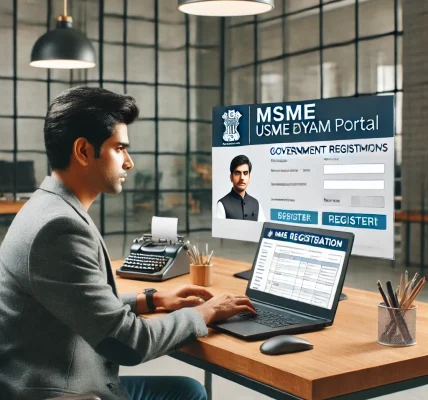Digital India: How Government Schemes Are Driving MSME Digital Transformation
In today’s rapidly evolving business landscape, digital transformation is no longer optional for small and medium-sized enterprises (SMEs), particularly Micro, Small, and Medium Enterprises (MSMEs) in India. These businesses, which form the backbone of the Indian economy, are increasingly turning to digital solutions to stay competitive, improve efficiency, and reach new markets. The Indian government, recognizing the importance of digitalization, has launched several initiatives and schemes under the Digital India campaign to support MSMEs in their digital journey.
This blog will explore how government schemes are driving the digital transformation of MSMEs, helping them embrace technology, streamline operations, and unlock new growth opportunities.
1. Introduction to Digital India and Its Impact on MSMEs
Digital India, launched in 2015 by the Government of India, is a national initiative aimed at transforming India into a digitally empowered society and knowledge economy. The program seeks to enhance digital infrastructure, improve digital literacy, and promote e-governance to make India a global leader in technology and innovation.
For MSMEs, the Digital India initiative presents an unprecedented opportunity to integrate technology into their day-to-day operations, marketing strategies, and customer interactions. With the right tools, MSMEs can improve efficiency, expand their reach, and compete globally.
However, the challenge for many small business owners is accessing the resources and support needed to adopt technology. To address this, the Indian government has rolled out several schemes and programs designed to help MSMEs make the digital leap.
2. Key Government Schemes Driving Digital Transformation for MSMEs
Several government-backed schemes under the Digital India initiative are specifically tailored to support the digital transformation of MSMEs. These schemes help businesses access funding, tools, and training to make their digital shift more effective and sustainable.
1. MSME Digital and Technology Upgradation Scheme
The MSME Digital and Technology Upgradation Scheme is one of the primary government programs aimed at supporting MSMEs in their digital transformation. The scheme provides financial assistance for technology upgradation, including the purchase of software, hardware, and digital tools to automate business processes.
- Key Features:
- Financial support for businesses to invest in enterprise resource planning (ERP) software and other productivity-enhancing tools.
- Assistance in digital infrastructure development, such as setting up websites, e-commerce platforms, and customer relationship management (CRM) systems.
- Funding to upgrade technology for better product quality and efficiency.
- Benefits:
- Reduces operational costs by automating routine tasks.
- Enhances customer engagement through digital marketing and e-commerce platforms.
- Enables MSMEs to adopt industry-standard technologies and enhance productivity.
2. Pradhan Mantri Digital Saksharta Abhiyan (PMDSA)
The Pradhan Mantri Digital Saksharta Abhiyan aims to digitally empower a large section of the Indian population by promoting digital literacy across rural and urban areas. This scheme is critical for MSME owners and employees who lack the basic digital skills required to operate in today’s market.
- Key Features:
- Digital literacy programs for business owners and employees, teaching basic computer skills, internet usage, and digital marketing.
- Training in using government portals and digital platforms like GST portals, e-Tendering, and e-commerce platforms.
- Benefits:
- Empowers MSME owners and their employees with the essential skills to operate in a digital world.
- Increases efficiency in using digital tools for marketing, accounting, and customer service.
- Improves the ability to access government services, register on online marketplaces, and file taxes digitally.
3. Technology and Innovation Support for MSMEs (TISPS)
The Technology and Innovation Support for MSMEs (TISPS) scheme, launched by the Ministry of MSME, focuses on technological advancements and innovation for MSMEs. Through TISPS, MSME owners are supported in adopting new technologies that can improve their processes and product offerings.
- Key Features:
- Provides support for the development and adoption of innovative technologies, such as cloud computing, IoT, and artificial intelligence (AI).
- Helps MSMEs collaborate with research institutions and technology developers to design and implement digital solutions.
- Benefits:
- Encourages innovation, which helps MSMEs stay competitive in the global market.
- Provides funding and mentorship for businesses looking to adopt new technologies.
- Facilitates the development of smart products and digital services that cater to a tech-savvy consumer base.
4. Digital MSME Scheme
The Digital MSME Scheme aims to promote the adoption of digital tools and platforms among MSMEs to streamline their operations, improve business processes, and enhance customer interaction.
- Key Features:
- Subsidies and financial support for MSMEs to adopt digital platforms like e-commerce, social media marketing, and data analytics tools.
- Training programs to enhance the digital marketing capabilities of MSME owners and their staff.
- Benefits:
- Helps MSMEs increase their online presence and reach a wider audience.
- Improves business efficiency by automating administrative tasks and streamlining operations.
- Enhances data-driven decision-making, leading to improved profitability.
5. Atal Innovation Mission (AIM)
The Atal Innovation Mission (AIM), launched by the NITI Aayog, supports innovation and entrepreneurship across various sectors, including MSMEs. AIM helps businesses explore digital solutions to improve their products, processes, and services.
- Key Features:
- Provides funding and support for research and development (R&D) projects that involve digital technologies.
- Encourages collaboration between MSMEs and startups for the development of new digital products.
- Benefits:
- Enables MSMEs to integrate digital innovation into their product offerings.
- Helps MSMEs scale their businesses by leveraging tech-driven innovations.
- Facilitates the creation of new digital business models that can revolutionize industry practices.
3. Benefits of Digital Transformation for MSMEs
The digital transformation of MSMEs through government schemes brings a multitude of benefits. Here are some key advantages:
1. Increased Efficiency and Productivity
By automating processes, digitizing inventory management, and integrating accounting software, MSMEs can reduce human errors and boost productivity. Digital tools also help businesses streamline their supply chains, reduce operational costs, and enhance their workflow.
2. Expanded Market Reach
Adopting digital platforms, such as e-commerce websites, online payment systems, and social media marketing, opens up new markets for MSMEs. These tools allow businesses to reach customers beyond local boundaries and explore global opportunities.
3. Enhanced Customer Engagement
With digital marketing tools, MSMEs can communicate more effectively with their customers. Through email campaigns, social media marketing, and customer relationship management (CRM) systems, MSMEs can provide personalized services and enhance customer satisfaction.
4. Better Financial Management
Digital tools help MSMEs streamline their accounting processes and ensure better tracking of revenues and expenses. They can also access digital platforms to avail of financial products, such as loans, subsidies, and grants, with ease.
5. Innovation and Product Development
Digital transformation enables MSMEs to integrate new technologies such as AI, cloud computing, and IoT into their business operations. This drives innovation, helping businesses create better products and services that meet the evolving needs of consumers.
4. How MSMEs Can Leverage Digital Government Schemes
To fully benefit from the government’s digital transformation schemes, MSME owners should:
1. Stay Informed
Regularly check updates from government ministries and agencies like the Ministry of MSME, NSDC, and NITI Aayog to remain informed about the latest digital initiatives and available funding.
2. Train Employees
Invest in digital literacy and training programs to ensure that your team is equipped with the necessary skills to work with new digital tools.
3. Apply for Financial Support
Take advantage of subsidies, grants, and loans under government schemes to upgrade technology, invest in digital tools, and enhance your business capabilities.
4. Implement Digital Solutions Gradually
Adopt digital solutions step by step, starting with simple tools like accounting software or an e-commerce platform, and gradually move towards more complex technologies like AI or IoT.
5. Conclusion
The Digital India initiative has paved the way for MSMEs to embrace the digital revolution, offering numerous opportunities for growth, efficiency, and innovation. Through various government schemes like the MSME Digital and Technology Upgradation Scheme, PMDSA, and TISPS, MSMEs can access the tools, training, and financial assistance needed to successfully transition into the digital era.
By leveraging these schemes, MSMEs can overcome their digital challenges, expand their market reach, and unlock new avenues for success. The digital transformation of MSMEs is no longer a choice – it’s a necessity for sustainable growth and global competitiveness.
With the right tools, support, and government backing, Indian MSMEs are well-positioned to embrace digital technologies and drive innovation, creating a strong foundation for the future.




